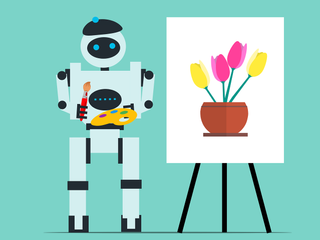AI art generators have become increasingly popular recently thanks to platforms such as Midjourney and Dall-E 2, which is owned by OpenAI, the maker of ChatGPT.
While not having yet dominated conversations in education the way ChatGPT has, these tools for creating art also have important implications in the classroom.
Artificial intelligence (AI) art generators create realistic images and/or illustrations in various styles based upon prompts provided by users. The digital tools have the potential to save students time with tedious work and could, in theory, help engage them, however, there are ethical concerns and debates about how best to use the technology in schools.
“What's happening in the art community and in the education community is people are saying either this is 100% the end of the world, or this is 100% the coming of a new god, and there’s nothing in between,” says Erik Fox-Jackson, Interactive Learning Designer at Adelphi University as well as an artist and graphic designer.
“Unfortunately, there are some bad ways of using it, but there are some good ways of using it too,” says Jaime Donally, an immersive learning expert. “People tend to just want to say one or the other, as opposed to really looking at it holistically and understanding that any technology can be used for good or bad.”
AI Art Generators Raise Different Ethical Questions Than ChatGPT
Fox-Jackson is a proponent of using AI technology in the classroom overall, yet cautions against using AI art generators with students. One reason is the legal issues raised by the technology, which draws from existing art online. “I think they're in sort of a legally problematic area that they need to resolve,” he says.
While there are also ethical concerns around use of ChatGPT, Fox-Jackson says these are not as baked into the technology. “ChatGPT is a large language generator,” he says. “So it basically knows how to assemble coherent sentences out of information, which is a little different than images where the images are something that's proprietary. The words are only proprietary when they're assembled in that specific way.”
However, ChatGPT can still commit plagiarism, although plagiarism isn’t as inherently a part of what it does. “There are times where ChatGPT looks at a specific string of words and goes like, ‘Yeah, that encapsulates it perfectly.’ And that's why students shouldn't use it to submit assignments,” Fox-Jackson says. “But as a learning tool, I think it's really valuable.”
Ways AI Art Generators Can Be Used Right Now
Brett Salakas, a veteran Australian educator and HP Education Ambassador, believes there are already compelling ways AI art generators can be used in the classroom.
For instance, in one writing and vocabulary lesson Salakas designed for middle school students, the teacher asks students to think about the main character in a story they would like to write. As a group, students come up with characters, which are often something silly such as a wacky cow. These words are then used as part of a prompt for DALL-E 2 and images of this student-created character are generated. “You’re demonstrating vocabulary, you’re scaffolding with the words, you’re setting the kids up for a successful writing lesson,” Salakas says.
Another approach for using AI art generators is to examine some of the problems with the technology. For instance, Salakas says when you ask DALL-E 2 to generate an image of a doctor, it tends to show you men, and if you ask for a nurse, it tends to generate images of women. Interrogating this lack of diversity and representation in the response can be an interesting exercise. “There’s a conversation to be had about the data set of the AI that we’re using,” Salakas says.
AI Art Generators: Potential and Pitfalls
Donally sees tremendous potential for ways in which AI art generators can be used to create 3D immersive experiences that can be used with the virtual reality (VR) and augmented reality (AR) lessons that are her focus as an educator. “We have the capabilities of being able to speak what we want to display in this immersive experience,” she says. “I think that is really powerful.”
Ultimately, this could save time and lead to richer immersive experiences being created by educators and students. However, Donally acknowledges that since many of these tools are currently subscription-based, that will limit the accessibility in classes. The copyright issues also need to be addressed.
Beyond potential legal implications, when it comes to art education in particular, Fox-Jackson believes AI art generators are not a great tool. “I think as often as possible students should stay away from image generators solely because this is students' only time to really experiment freely,” he says. Using such a tool seems to be the antithesis of fostering creativity.
While Fox-Jackson will use an AI art generator for presentations himself, he says he’s able to generate quality products because of his solid foundation in art and design. “As a person who's gone through art school, I've learned certain principles that I'm able to then feed into the image generator and get better results,” he says. “Because I've art-directed photo shoots, I know the kind of lens you would use for a great photo. Because I've taken color theory classes, I know that blue orange contrast is really exciting to the eye.”
In other words, at least for now, an artist’s eye and human creativity is still an important part of the process of creating quality images. Good educators can help their students navigate these new technologies but they should always keep the emphasis on human creativity.

